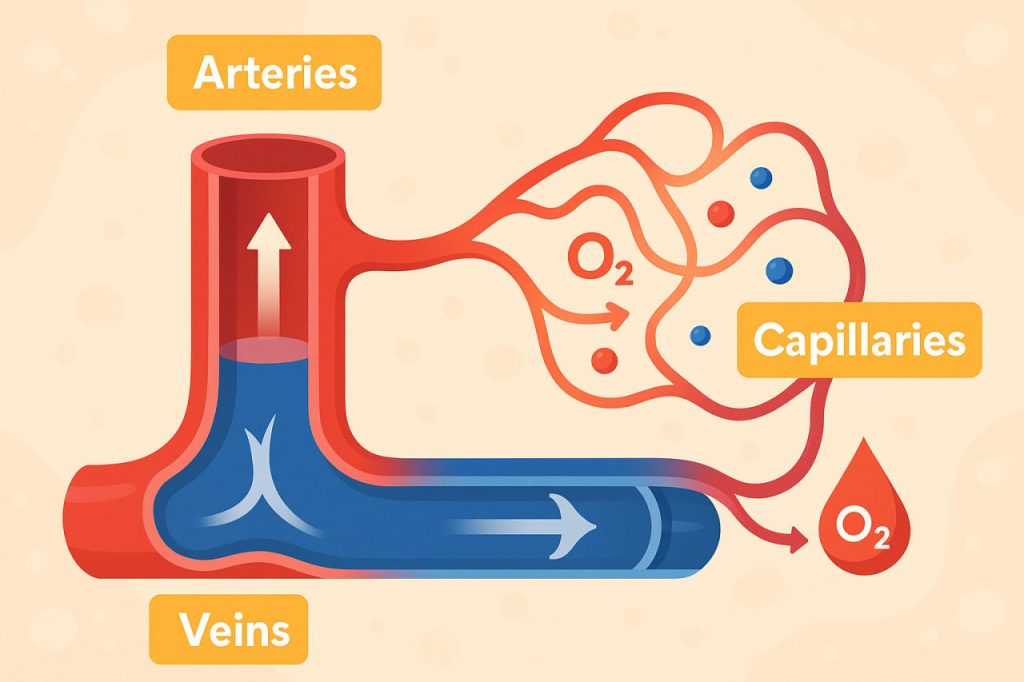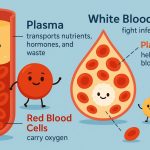The circulatory system is one of the body’s most vital networks, ensuring that every organ and cell receives oxygen, nutrients, and protection. At the core of this system are the blood vessels — flexible tubes that transport blood throughout the body. Without them, life would be impossible, as tissues would be starved of oxygen and unable to remove waste products.
Types of Blood Vessels
- Arteries
- Carry blood away from the heart.
- Have thick, elastic walls that can withstand high pressure from the pumping heart.
- The largest artery is the aorta, which branches into smaller arteries and eventually into arterioles.
- Function: deliver oxygen-rich blood to tissues (except pulmonary arteries, which carry oxygen-poor blood to the lungs).
- Veins
- Carry blood back to the heart.
- Have thinner walls than arteries and contain valves that prevent backflow of blood.
- Rely on muscle contractions and low pressure to return blood to the heart.
- Function: return oxygen-depleted blood to be reoxygenated in the lungs.
- Capillaries
- The smallest blood vessels, only one cell thick.
- Connect arteries and veins.
- Allow exchange of gases, nutrients, and waste between blood and surrounding tissues.
- Function: serve as the site of actual nutrient and oxygen delivery to cells.
Structure of Vessel Walls
Blood vessel walls consist of three layers:
- Tunica intima – the innermost smooth layer that reduces friction for blood flow.
- Tunica media – the middle layer of smooth muscle and elastic tissue that regulates vessel diameter.
- Tunica externa – the outer protective layer made of connective tissue.
Capillaries are simpler, with only one thin cell layer to allow efficient exchange.
Functions of Blood Vessels
- Transport – Deliver oxygen and nutrients to cells, remove carbon dioxide and waste.
- Regulation of blood pressure – Arteries adjust their diameter to control pressure and flow.
- Temperature control – Blood vessels expand to release heat or constrict to preserve warmth.
- Immune defense – Leukocytes travel through vessels to reach infected or injured tissues.
- Wound healing – Platelets and clotting factors are delivered through vessels to stop bleeding.
Why Blood Vessels Are Essential
Blood vessels form the infrastructure of life, ensuring that every part of the body is nourished, protected, and maintained. Problems with blood vessels — like atherosclerosis, hypertension, or varicose veins — can lead to serious health conditions such as heart attacks or strokes.
Conclusion
Human blood vessels are a highly organized network of arteries, veins, and capillaries, each with specialized structures and functions. Together, they transport essential substances, regulate pressure and temperature, and support immune responses. Protecting vessel health through proper diet, exercise, and medical checkups is vital for maintaining overall well-being.
Glossary
- Aorta – the main artery leaving the heart.
- Valves – structures in veins that prevent blood from flowing backward.
- Capillaries – the smallest vessels where exchange with tissues occurs.
- Atherosclerosis – narrowing of arteries due to plaque buildup.
- Blood pressure – the force of blood pushing against vessel walls.


